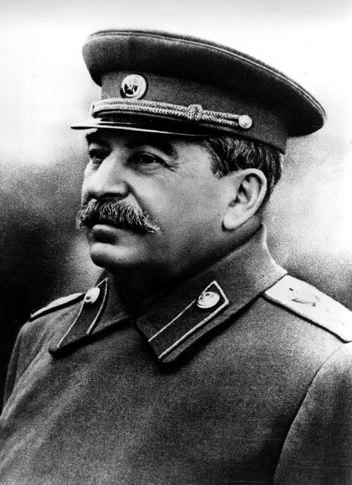
Vladimir Lenin pioneered modern political mass murder by announcing his intention to liquidate the “bourgeoisie” as a class. Josef Stalin, who was Lenin’s successor and Hitler’s patron, faithfully implemented Lenin’s murderous designs during the Soviet regime’s campaign to liquidate the Ukrainian “kulak” farmers. The engineered Ukrainian famine introduced many of the methods that were later used by Hitler in the National Socialist campaign against the Jews.
Starving the Enemy
The Ukrainian famine was produced by the Soviet government’s drive to collectivize that nation’s agricultural system, which for centuries had been the “granary of Europe.” Collectivization would make possible the Soviet oligarchy’s desire to finance its arms build-up through agricultural exports. Furthermore, destruction of Ukraine’s agricultural economy was seen as a natural complement to the Soviet government’s campaign against the independent Ukrainian Orthodox Church, and the decapitation of the nation’s intelligentsia. That campaign began in 1929, when Stalin’s government began to banish, imprison, and execute troublesome Ukrainian clerics, writers, and political officials.
To break the resistance of Ukrainian farmers, the Soviets attempted to herd them onto kolkhozes, or state-owned collective farms. Those who held out were denounced as “kulaks” or podkulachniki (“kulak henchmen”). “Either we go backward to capitalism or forward to socialism,” declared Stalin on December 27, 1929. “What does this mean? It means that after a policy that consisted in limiting the exploitive tendencies of the kulaks, we have switched to a policy of eliminating the kulaks as a class.”
In the 1935 Nuremberg Laws, the Nazis created a specific — if highly arbitrary — set of guidelines to define those who were deprived of citizenship and individual rights; Stalin’s definitions were much more flexible. “The term kulak had never been defined,” recall Soviet expatriate authors Mikhail Heller and Aleksandr Nekrich in their study Utopia in Power. “Anyone who employed hired labor was considered a kulak, but so was anyone who owned two horses or two cows or a nice house. Since there was no clear notion of what a kulak was, overall quotas for dekulakization and collectivization were assigned for each region.” Of course, the category of “kulak henchmen” included anyone who was targeted by communist authorities for any reason.
The propaganda tropes and techniques used by the Soviets to dehumanize the kulaks eerily prefigured those employed by the Nazis. For example, handbills and posters depicted the typical kulak as a spider diabolically spinning a web of “exploitation” — a motif borrowed by the Nazis and applied to Jews. Furthermore, just as the Nazis invoked a Jewish “threat” to civil order as a pretext for Kristallnacht and the “protective” incarceration of Jews, the Soviets insisted that repressive measures in Ukraine were made necessary by the insidious actions of “insurrectionists,” “terrorists,” and “wreckers.”
One of the most haunting images associated with the Holocaust is that of men, women, and children being herded into boxcars destined for the Polish extermination camps. Once again, Hitler merely followed the model created by Stalin. “Kulaks and their ‘henchmen’ were deported with all of their families, including infants and old people,” recall Heller and Nekrich. “Hundreds of thousands were shipped in unheated boxcars thousands of kilometers away to remote parts of the Urals, Siberia, and Kazakhstan. Many died en route; many others died after their arrival, for as a rule they were deported to uninhabitable locations….” In 1937, Soviet expatriate writer Walter Krivitsky described the scene he came across at a railroad station in Kursk during the dekulakization campaign: “In the waiting area there were nearly six hundred peasants — men, women, and children — being driven from one camp to another like cattle…. Many were lying down, almost naked, on the cold floor. Others were obviously dying of typhoid fever. Hunger, torment, and despair were written on every face.”
Rough Body Count
Those who remained in Ukraine fared little better. In 1932, as depicted in the Canadian documentary Harvest of Despair, the Soviet government dispatched an army of Chekists (secret police) and Party members to collect all of the grain from the collective farms — including the chaff — and to guard all stores of food and livestock against the starving population. Soviet military and security forces also sealed off Ukraine’s borders.
The clear intention was to slaughter as many Ukrainians as possible through the protracted agony of hunger. In many tragic instances, the victims were reduced to cannibalizing those who perished.
A definitive casualty count of the terror famine “has never been, and will never be, determined exactly,” note Heller and Nekrich. “The losses of livestock were calculated, on the other hand, down to the last sheep.” The Soviet government ceased to publish birth rates and mortality figures in 1932; however, Stalin told the 17th Party Congress in 1934 that the Soviet Union (including Ukraine) had actually enjoyed a population increase of nearly eight million between 1930 and 1933. The dictator and his co-conspirators clearly knew better.
In the early1930s, as the regime covered up its planned liquidation of the kulaks, sold the expropriated grain on international markets, and escorted gullible or dishonest foreign celebrities through propaganda tours displaying Ukraine’s “abundance,” the GPU secret police compiled a preliminary estimate that more than three million kulaks had been slaughtered. In 1935, Soviet Foreign Minister Molotov reported that where the kulaks had numbered 5,618,000 in 1928, only some 149,000 survived collectivization. Chekist official Aleksandr Orlov estimated that the famine claimed up to seven million victims.
In 1974, Soviet demographer Boris Urlanis noted a population loss of 7.5 million between the end of 1932 and the end of 1933 — the period in which the engineered famine was at its height. At about the same time, underground Soviet writer I.G. Dyadkin published an essay presenting the case for a casualty count of 15.2 million people. Stalin himself boasted — yes, boasted — to Churchill in 1943 that the “poor peasants” had taken reprisals against “ten million kulaks,” the vast majority of whom were slaughtered, and the rest sent to Siberia.
Truth and the Pulitzer Prize
While the apparatus of Soviet repression controlled dissemination of the facts about the Ukrainian genocide within the USSR, Western correspondents — chief among them Walter Duranty, Moscow correspondent for the New York Times, “distorted and interpreted the facts falsely” in order to deceive the West, write Heller and Nekrich. “Progressive” groups worldwide recruited intellectuals to visit the Soviet Union, which was hailed in a typical pitch as “the greatest social experiment in the world.” Among the political tourists who publicly denied the famine after taking state-sponsored propaganda tours were Fabian Socialists Sydney and Beatrice Webb and George Bernard Shaw. “The few Western intellectuals who tried to poke a hole in the iron curtain to expose the conspiracy of lies about the Soviet Union and write the truth about it were pitilessly ostracized from the camp of progressive humanity,” Heller and Nekrich observe.
One such ostracized truth-teller was the young British journalist Malcolm Muggeridge, who was sent to Moscow in 1932 as a stringer for the Manchester Guardian. Although his announced purpose was to assist in the grand project of “building socialism,” his misplaced idealism dissolved like cotton candy in an acid bath once he learned the grim truth. In March 1933, Muggeridge revealed to his paper’s readers that the Ukrainian peasantry was “starving in its absolute sense” as a result of an organized famine and “active war” waged against them by the Soviet government. His stories were smuggled out by diplomatic pouch — only to be mutilated by his pro-Soviet editors and relegated to the back pages. He was denounced in public by Beatrice Webb — his former mentor and mother-in-law — and found himself unable to find work as a journalist once he returned to London.
While Muggeridge was struggling to get the truth to the public, Walter Duranty of the New York Times was polluting newsprint with pro-Soviet lies denying the famine. Typical of Duranty’s dispatches — and uncannily prefiguring the approach favored by some Holocaust deniers — was an article in the March 31st New York Times, in which he insisted that “there is no actual starvation or deaths from starvation but there is widespread mortality from diseases due to malnutrition.” Parroting the Soviet party line, Duranty insisted that the “wreckers” and “spoilers” had “made a mess of Soviet food production.” In other reports, Duranty dismissed accounts of famine as “mostly bunk.”
For the articles in which he faithfully retailed Soviet propaganda, Duranty was awarded the Pulitzer Prize in 1933. The Committee took special note of the “scholarship, profundity, impartiality, sound judgment, and exceptional clarity” with which he covered Soviet affairs, including the Ukrainian “non-famine.” Shortly thereafter, the FDR regime extended diplomatic recognition to the USSR, thereby opening the aid spigot on behalf of the most murderous regime in history.
On his trip home from Soviet Russia, writes S.J. Taylor in Stalin’s Apologist, his 1990 biography of Duranty, Muggeridge stopped off in Berlin, “where he ‘watched the Nazis march along the Unter den Linden and realized, of course, they’re Comsomols, the same people, the same faces. It’s the same show.’”
Until sufficient understanding is reached that all variants of collectivism are essentially “the same show,” the potential will exist that crimes such as those perpetrated by the Soviet and Nazi regimes will be committed anew.



